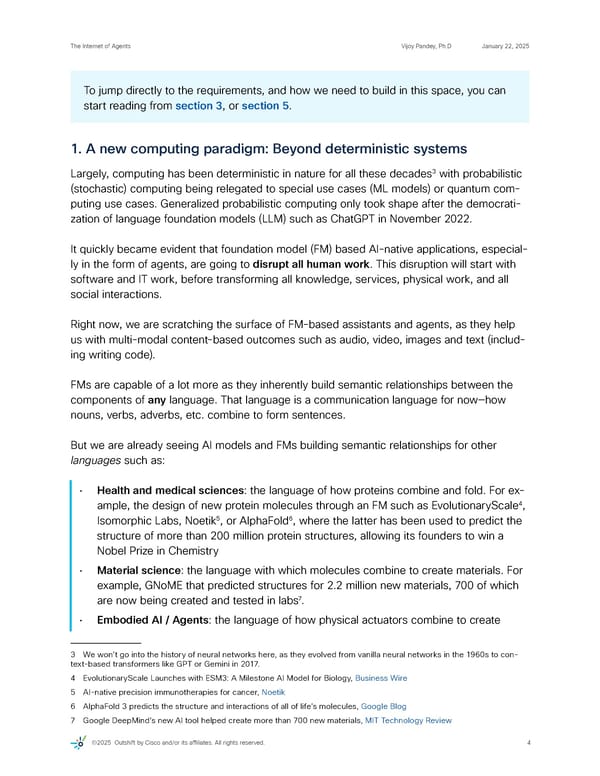The Internet of Agents Vijoy Pandey, Ph.D January 22, 2025 To jump directly to the requirements, and how we need to build in this space, you can start reading from section 3, or section 5. 1. A new computing paradigm: Beyond deterministic systems 3 Largely, computing has been deterministic in nature for all these decades with probabilistic (stochastic) computing being relegated to special use cases (ML models) or quantum com- puting use cases. Generalized probabilistic computing only took shape after the democrati- zation of language foundation models (LLM) such as ChatGPT in November 2022. It quickly became evident that foundation model (FM) based AI-native applications, especial- ly in the form of agents, are going to disrupt all human work. This disruption will start with software and IT work, before transforming all knowledge, services, physical work, and all social interactions. Right now, we are scratching the surface of FM-based assistants and agents, as they help us with multi-modal content-based outcomes such as audio, video, images and text (includ- ing writing code). FMs are capable of a lot more as they inherently build semantic relationships between the components of any language. That language is a communication language for now—how nouns, verbs, adverbs, etc. combine to form sentences. But we are already seeing AI models and FMs building semantic relationships for other languages such as: • Health and medical sciences: the language of how proteins combine and fold. For ex- 4 ample, the design of new protein molecules through an FM such as EvolutionaryScale , 5 6 Isomorphic Labs, Noetik , or AlphaFold , where the latter has been used to predict the structure of more than 200 million protein structures, allowing its founders to win a Nobel Prize in Chemistry • Material science: the language with which molecules combine to create materials. For example, GNoME that predicted structures for 2.2 million new materials, 700 of which 7 are now being created and tested in labs. • Embodied AI / Agents: the language of how physical actuators combine to create 3 We won’t go into the history of neural networks here, as they evolved from vanilla neural networks in the 1960s to con- text-based transformers like GPT or Gemini in 2017. 4 EvolutionaryScale Launches with ESM3: A Milestone AI Model for Biology, Business Wire 5 AI-native precision immunotherapies for cancer, Noetik 6 AlphaFold 3 predicts the structure and interactions of all of life’s molecules, Google Blog 7 Google DeepMind’s new AI tool helped create more than 700 new materials, MIT Technology Review ©2025 Outshift by Cisco and/or its afÏliates. All rights reserved. 4
 The Internet of Agents | Digital paper Page 3 Page 5
The Internet of Agents | Digital paper Page 3 Page 5